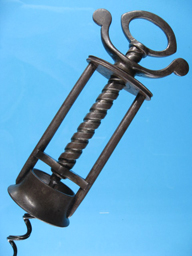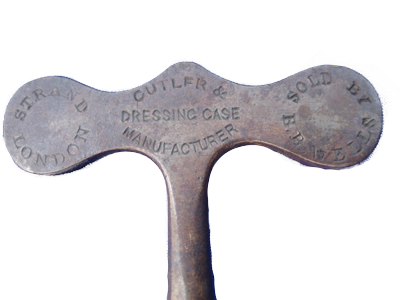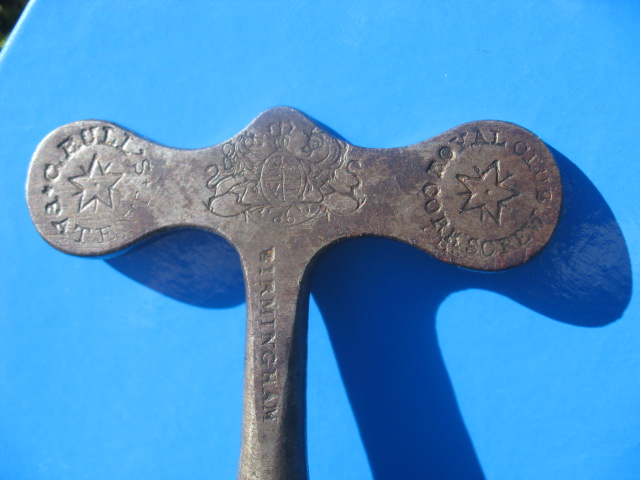Corkscrews Marked BB Wells.
By Brian May and Steven Webb
Interest in B B WELLS, was stimulated by the superb two-pillar steel corkscrew with a double wing nut, marked B B WELLS 431 WEST STRAND on the top oval handle. An identical corkscrew can be seen in “Corkscrews”, page 137 by Ellis and Ellis.

At some stage corkscrew collectors will come across B B WELLS particularly if they collect steel folding bows. Who was B B WELLS?
This is Benjamin Blake Wells who was born about 1817 in Dunstable, Bedfordshire 60km north of London. The family moved to London where father William was a Mail Coachman. In 1845 Benjamin Blake married at Stepney St Dunstan and All Saints, Middlesex, giving his residency as Stepney and his occupation as “manager in business”. He was 28 years of age and probably already a qualified cutler.
Wells first appeared in London Trade Directories in 1850 as a cutler and dressing case maker. As a qualified cutler he applied to be a Freeman of the City of London on 6th October 1856 (see document below) and his address was shown as 143 Leadenhall Street.
![]()
Wells lived with his wife and three sons at 431 Strand London from at least 1851 (he is shown in the 1851 UK census at this address) and remained there until his death in 1881. Wells also had his business at 143 Leadenhall Street as indicated but had left this address by 1870 and was then located at 138 and 431 Strand. By 1880 he was only listed at 431 Strand.
There is a lot of confusion over whether some London cutlers were actually working cutlers (manufactured knives, corkscrews etc) rather than just retail outlets.
Wells consistently gave his occupation in London trade catalogues and UK censuses as “cutler and dressing case maker” from 1851 until the year of his death. The 1871 census shows he “employed 7 hands” establishing that he was certainly a manufacturer at this time. Manufacturing probably took place at Leadenhall Street until 1870 (and later 138 Oxford Street), with his home and main retail outlet at 431 Strand.
Benjamin Blake Wells died on 19 August 1881 leaving an estate to of £1339 18s 8d (about £50,000) to his Surrey gentleman son, Charles the only executor. The other two sons had died.
Interestingly the business continued for another 30 years at 431 Strand. In 1890, there is an entry in the directory that shows B B WELLS as a razor maker and a manufacturing cutler. In 1895 the business is additionally listed as a pen and pocketknife maker. There is an entry in the 1912 directory but not in 1915.
So what items did the business of B B WELLS sell?
Over the years WELLS sold both high end and more mundane items all marked with B B WELLS. These included chess sets and elegant tortoise shell boxes etc. It seems reasonably certain that he manufactured bar implements, farrier tools, dressing boxes, razors (marked B B WELLS RAZOR MAKER), surgical instruments and superb folding knives. The latter were often marked LONDON MADE B B WELLS. There is no doubt then that he manufactured razors and folding knives.
He also sold corkscrews (again all marked with B B WELLS) with the most prolific being multi-tool steel bow corkscrews (even one with 11 tools). Here is an example of a five-tool bow corkscrew.
.jpg)
From about 1854, Wells sold other high quality and desirable corkscrews marked B B WELLS (together with for example either WEST STRAND, STRAND LONDON or 431 STRAND) but almost certainly did not make them. For example he sold patented corkscrews: John Coney’s 1854 patent No 1811 clutch mechanism corkscrew and marked with a crown and “V. R. B. B. Wells, Patent”; Charles Hull’s 1864 patent Royal Club with the marking “SOLD BY BB WELLS STRAND LONDON CUTLER AND DRESSING CASE MANUFACTURER” and Charles Chinnock ‘s 1862 patented corkscrew marked B.B. WELLS STRAND AND CITY LONDON.

Here is an image of a Rare Hull Royal Club corkscrew with markings as mentioned above, it's rare due to there being no badge or badge holder.
The top image clearly shows the markings on one side of the top handle. Below we can see the reverse side of the top handle.
We can see the markings "HULL'S PATENT", "ROYAL CLUB CORKSCREW", in the centre we there is a Lion and Unicorn, as often found on corkscrews.
As indicated earlier Wells also sold a steel two-pillar corkscrew with two top handles marked B B WELLS 431 WEST STRAND. A very similar but not identical two-pillar corkscrew marked B B WELLS 431 STRAND AND 143 LEADENHALL ST was sold at a Christie’s auction in October 2006. This latter corkscrew (see below) from the above research can be dated from 1850 to 1870.
.jpg)
Perhaps Fletcher Wallis (page 6 of British Corkscrew Patents from 1795) best summed the situation up when he said that Wells, “sold a wide range of corkscrews, mostly not of his own manufacture”.
So all one can say with certainty, if you have a corkscrew marked with B B WELLS, is that the corkscrew was made in the second half of the 19th century or possibly very early 20th century (when in fact WELLS was not alive) and sold by the B B WELLS business from the retail outlet at 431 WEST STRAND. Precisely which corkscrews he manufactured cannot be determined since they were never as far as we know, marked accordingly eg. LONDON MADE B B WELLS or B B WELLS MAKER.
Thus, the two-pillar corkscrews marked B B WELLS, may well have been manufactured elsewhere perhaps Sheffield or Birmingham and then stamped with the retailer’s name.
Sources: UK censuses, The London Knife Book by Ron Flook, website ancestry.co.uk.
Acknowledgment: We thank Richard Stevenson for the photograph of the five tool bow corkscrew.



